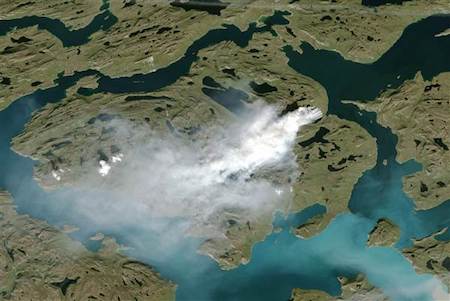|
By Elizabeth Chuck, NBC
NBC News
Tuesday, Aug 22, 2017
An Unusually Large Wildfire Has Burned for Weeks in Icy Greenland
 |
| This NOAA handout satellite photo taken on August 3, 2017 shows a cloud of smoke from wildfires burning in western Greenland, about 150 kilometers (90 miles) northeast of Sisimiut. file Handout / AFP - Getty Images file |
There's something curious happening in icy Greenland: a wildfire that has been burning for weeks.
The wildfire appears to be historic in both its size and its duration, but no one can say for sure — because Greenland doesn't have longstanding records of fires. Officials haven't had much of a need for them, seeing as nearly 80 percent of the Arctic island is covered in an ice sheet.
"There are wildfires, but it's not a typical wildfire environment, and it's a remote area," said Stef Lhermitte, a remote sensing scientist at Delft University of Technology in the Netherlands.
At about two square miles, this wildfire is relatively small compared to others around the world. But it's the biggest in Greenland since satellite record-keeping began in 2000.
This one was first spotted on satellite on July 31 in western Greenland, about 90 miles northeast of the city of Sisimiut — and it's still burning.
Past wildfires in Greenland have only lasted one to three days, said Dr. Jessica McCarty, an assistant professor of geography at Miami University in Oxford, Ohio, and an expert in satellite data analysis. This one is about 40 miles west of the ice sheet.
"It's concerning," McCarty said. "This is not usual."
News of the wildfire has intrigued scientists from around the globe, many of whom have been sharing statistics about Greenland on social media as researchers try to piece together Greenland's history to determine whether this is unprecedented.
Lhermitte, the remote sensing scientist, found that this year has had the highest number of fire detections on record.
According to NASA, that may be because Greenland has had a dry summer: Sisimiut got almost no rain in June, and half the usual amount in July.
"That may have parched dwarf willows, shrubs, grasses, mosses, and other vegetation that commonly live in Greenland’s coastal areas and made them more likely to burn," NASA said.
Since there haven't been any casualties reported, no firefighters have been dispatched to fight the wildfire, meaning it will be left to burn until it extinguishes on its own — which could be as late as mid-September, when rain and snow typically fall.
In the meantime, there have been economic and environmental consequences. Because the blaze is near Arctic Circle trails that attract tourists in the summer, local police have warned hikers to stay away, citing smoke concerns.
"The smoke is spreading hundreds of miles to all sides," local police wrote in a Facebook post. "The smoke may cause people to lose their bearings in the areas. There is no prospect that the fires will cease in the next few days. The authorities are following developments closely."
It's also destroyed the habitat for reindeer, which herd in the area.
"Reindeer are very important for the people who live in Greenland because they often use wild meat sources to supplement their main protein sources," McCarty said. "They probably won't come back to graze here for quite some time until the landscape has recovered, and it will take years to recover."
The problems don't end there. The smoke from the wildfire could have a shrinking effect on Greenland's ice sheet.
"Smoke contains certain atmospheric species that can cause the ice sheet to melt faster, in particular black carbon," McCarty said. "Black carbon can be thought of as soot because it's so dark. When it deposits on the ice, which is very light, it just heats up very quickly and causes more melting on the surface."
No one knows the cause of the wildfire. There haven't been reports of lightning in the area, making it more likely that the fire was caused by a human rather than by natural causes, possibly by accident.
McCarty and others believe the persistence of the fire indicate it's burning peat, high-carbon content soil. That's cause for alarm because if the ice sheet and permafrost in Greenland continue to melt, more peat will be uncovered, which could lead to more fires like this in the future.
Ruth Mottram, a climate scientist at the Danish Meteorological Institute, said temperatures have risen in Greenland.
"The monthly average temperature was 7.1 Celsius compared to a 1961-1990 average of 6.3 Celsius in July. The trend has continued into August as well," Mottram told NASA earlier this month.
But scientists are hesitant to say climate change has contributed to the Greenland fire. Researchers need more data on what the area usually looks like at this time of year.
Source URL
|
 Print This Print This

|

